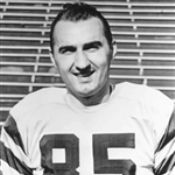 | |
| Founded | 1941 |
|---|---|
| Folded | 1950 (Merged with Hamilton Tigers) |
| Based in | Hamilton, Ontario, Canada |
| League | Ontario Rugby Football Union Interprovincial Rugby Football Union |
| Team history | Hamilton Wildcats (1941–1942, 1945–1949) Hamilton Flying Wildcats (1943–1944) |
| Team colors | Red, White |
| Grey Cup championships | 1 (1943) |
| Home field(s) | Civic Stadium |
The Hamilton Wildcats were a Canadian football team based in Hamilton, Ontario that played in the Ontario Rugby Football Union (ORFU) from 1941 to 1947, and in the Interprovincial Rugby Football Union (IRFU) from 1948 to 1949. The team was formed to play in the ORFU in 1941 to fill the void left by the Hamilton Tigers, who ceased operations that year due to a large number of players joining the army. [1] In 1943 and 1944, the team assumed the name Hamilton Flying Wildcats to reflect the Royal Canadian Air Force personnel on the team. [1] [2] After struggling to compete on a sound financial level with the Hamilton Tigers, who resumed operations following World War II, the two clubs merged in 1950 to form the Hamilton Tiger-Cats. [3]

Canadian football is a sport played in Canada in which two teams of 12 players each compete for territorial control of a field of play 110 yards (101 m) long and 65 yards (59 m) wide attempting to advance a pointed oval-shaped ball into the opposing team's scoring area.

Hamilton is a port city in the Canadian province of Ontario. An industrialized city in the Golden Horseshoe at the west end of Lake Ontario, Hamilton has a population of 536,917, and a metropolitan population of 747,545. The city is located about 60 km southwest of Toronto, with which the Greater Toronto and Hamilton Area (GTHA) is formed.
The Ontario Rugby Football Union (ORFU) was an early amateur Canadian football league. As its name implies, it comprised teams in the Canadian province of Ontario. The ORFU was founded in 1883 and in 1903 became the first major competition to adopt the Burnside rules, from which the modern Canadian football code would evolve.


